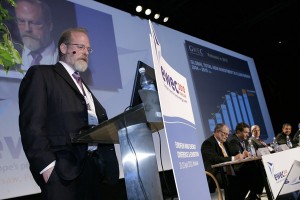Wind power supporters in the United States were told this week that the military understands the importance of the emissions-free technology.
General Victor E. Renuart, Jr., who is in charge of the North American Aerospace Defense Command (Norad) at Peterson Air Force Base in Colorado, said the military is dedicated to both homeland defense and clean energy.
“We feel strongly that alternate [energy] sources are vital to our nation’s future,” Renault said in his commander’s blog. “I also know that the defense of our homelands is an equally vital responsibility. I honestly believe that both can be achieved together.”
Norad is charged with the missions of aerospace warning and aerospace control for North America. The Norad website says aerospace warning includes the monitoring of man-made objects in space, and the detection, validation, and warning of attack whether by aircraft, missiles, or space vehicles. Aerospace control includes ensuring air sovereignty and air defense of the airspace of Canada and the United States.
According to Associated Press, construction of a 338-turbine wind farm in Oregon has been put on hold while experts study whether it will interfere with a nearby radar station. AP said the Federal Aviation Administration, with Air Force backing, issued a notice in March that effectively bars construction. The Defense Department asked the Massachusetts Institute of Technology’s Lincoln Laboratory to investigate.
In his blog, Renault, who also directs the US Northern Command, said the military appreciates “the importance of projects that enable the energy independence of both the US and Canada, and we fully support their development.”
The general said planners regularly evaluate proposed development projects such as wind farms, hotels, or other structures to assess whether they could hinder the military’s ability to detect and provide the warning and defense necessary to keeping North America safe.
Renault also said military planners suggest potential solutions to possible problems discovered in such development proposals.
“These situations really don’t happen all that frequently,” he said.
 US President Barack Obama was promoting wind power on Earth Day. Saying that Americans have worked hard to clean up the environment in the past 40 years, Obama said there is still much to do.
US President Barack Obama was promoting wind power on Earth Day. Saying that Americans have worked hard to clean up the environment in the past 40 years, Obama said there is still much to do.






 Comments
Comments
